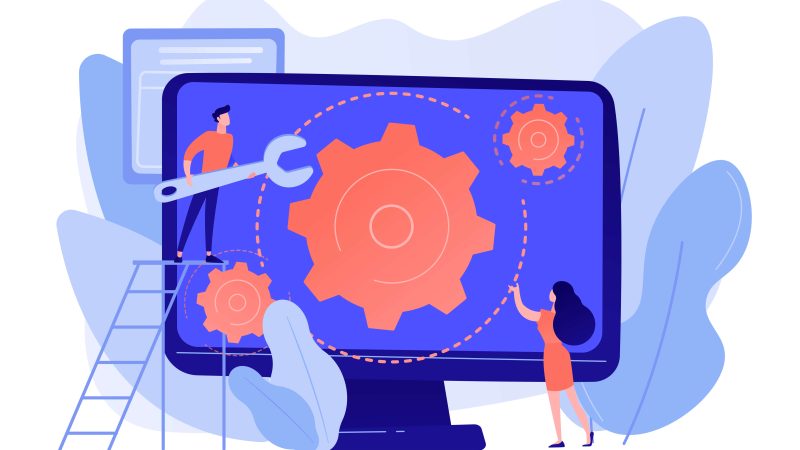Software Development Life Cycle Process: Phases and Main Peculiarities

A software development lifecycle (SDLC) is a methodology that is utilized throughout the software development process. SDLC follows standard business practices to build software applications efficiently and qualitatively. It helps the team in managing and simplifying each stage of the software development process. SDLC leverages software teams to develop high-quality and cost-effective software solutions in the shortest possible production time. There is a wide range of SDLC models that can be adopted by software organization as per their needs and requirements. Let’s explore the two most common software development methodologies.
Agile: A SDLC model that follows the iterative process and quickly adapts to the changing needs is known as the agile model. The work is divided into small sprints with specified deliverables that are usually completed within some weeks or a month. Agile features a lot of benefits such as improved productivity, reduced risks, fast time-to-market, responsiveness, etc. Scrum, Kanban, and Extreme programming are the three most popular agile frameworks.
Waterfall: Waterfall is an SDLC model in which project activities are broken down into linear sequential phases, which means that the team proceeds to the next stage after completing the previous one. This flow of the waterfall model makes changing difficult once the project moves to the next phase. It’s ideal for projects with clarified project requirements.
What are the different stages of the software development lifecycle?
The following are the different stages of the software development lifecycle:
Project planning
The first phase of the SDLC is project planning which is ideal to identify the purpose of creating software. It helps in building up the project’s team and leadership structure. After the creation of the team, the project manager and stakeholders discuss the project objectives and goals of the project with the team members. The scope of the project, timeline, budget, and milestones to be achieved are identified in this stage. The purpose of this phase is to ensure the team has a clear understanding of the importance and purpose of developing a project. It also helps in maintaining smooth communication among the team members, managers, and stakeholders.
Requirement analysis
The requirement gathering and analysis of the project is essential to know how the software is going to work and how it will solve the specific problem for which it will be created. If you’re building software for a client, then it’s a must to cater to the client’s needs and requirements. Ask the client about the goals needed to be accomplished through the software. Conduct an in-depth analysis of the project features & functionalities, and most importantly know about your target audience. Gather information about the project and identify for which platform you want to develop software such as android, iOS, Windows, etc.
Design
The design phase comprises the creation of two steps: prototyping and user interface, which involves coordination with the design team. In the prototyping stage, two types of wireframes are created known as low-fidelity wireframes and high-fidelity wireframes. The wireframe is the structure or skeleton of a website that is created to identify the informational flow, content placement, user-interface screens, etc. of a software. At low-fidelity level design, the screens are sketched roughly on a piece of paper which are tested by the team themselves. While high-fidelity designs are created on software that is also known as prototypes. The prototype design is tested to know how the software will work before it is put into production. Prototypes are tested by the end-users. After the successful testing of the prototype design, the software then proceeds to the designing phase.
The user interface is a part of the designing phase where the design team builds the actual interface of the software by selecting the design elements, typography, font, images, and color palette. Each screen created in a prototype is implemented in the UI phase with a simple and easy-to-use interface.
Implementation
This phase is one of the most critical and time-consuming phases as the developers write the actual code of the project. The developer’s team can choose a programming language and framework for the software implementation according to the project requirements. The developer implements different features and functions of the project that were discussed earlier in the requirement analysis phase. Coding and database designing of the software are involved at this stage. The code and database are linked together to ensure the software is completely functional. The developer’s team can make changes in the software if they follow agile SDLC. It will also help developers to quickly adapt to the changing trends in the software.
Testing
To ensure the software is bug-free and running properly in terms of speed, functionality, and usability, the quality assurance team tests the software. Identifying bugs, glitches, defects, and broken code in the software is essential before its release. The QA team conducts different types of testing, including functional testing, regression testing, integration testing, load testing, usability testing, security testing, smoke testing, etc. Testing is an important step, without this, a software might lack the performance and can create serious issues in the overall software.
Deployment
To guarantee that the software is operating and performing properly on a target device, it is deployed at the server-side or in the production environment. The project’s deployment ensures that everything is going as planned and that the software isn’t having any issues while running on both the production and consumer sides. With software deployment, accurate updates, software, maintenance activities, and uninstall can all be targeted automatically, and PCs may be examined for faults in real-time.
Also Read: What is Quality Assurance| Know All About It
Launch and maintenance
Once the software is deployed and running well on the targeted device, it’s time to finally launch it to the market. At this stage, your target audience will be using your software. After the successful launch, you need to keep it maintained and updated.
The following factors are considered in the maintenance phase:
- Scanning for viruses and vulnerabilities
- Bug fixing and repairing
- Improvement in performance
- Latest OS versions support
- Code optimization
- Implementing latest trends
- Third-party services support
Final words
When creating software, it’s essential to follow the software development methodology to ensure the project is developed smoothly and efficiently. Each phase of SDLC has its own importance and neglect that can lead to serious troubles within the overall project development. Therefore, selecting the SDLC that best suits your project need can be very beneficial. However, if you’ve well-defined and clear project goals and requirements, then waterfall can be an ideal choice. Agile on the other hand, is a new approach to software development and is6X more successful than other software methodologies.






